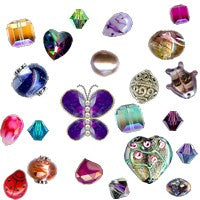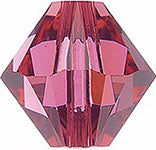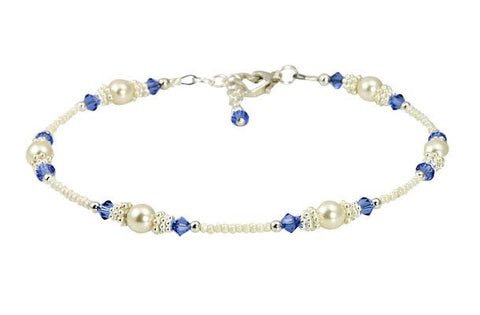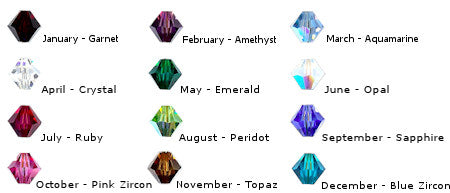Bead Glossary
Beads, Crystal, Gemstones, Lampwork, Pearls and Silver Beads glossary descriptions and information for materials used in SWCreations Beaded Jewelry Designs.

Bali Silver
Imported handcrafted sterling silver beads from Bali Indonesia. Made with a minimum of 92.5% sterling silver and 7.5% copper. The silver used on this website is nickel free. Bali .925 silver beads are available in an oxidized finished with the black accents and a bright finish look. They are both .925 silver and it is just a matter of customer preference of which one looks best. They are also available in an unusual look consisting of copper and .925 silver.
There is a difference between Bali beads and Bali style beads. True Bali Beads are actually crafted in Indonesia where other Bali style beads are created to imitate the style of Bali silver beads. The Bali beads are very amazing with such a variety of intricate patterns in the silver.
Bali Gold Vermeil-Beads
These beads are created with 24k karat gold electroplating over Bali .925 sterling silver beads.
Bicone
A diamond-like shape created from two faceted cones lined up and connected at the base. Swarovski crystals come in a variety of sizes ranging from 3mm to 12mm in size. You can also find China glass beads in the Bicone shape, but they just do not stand up to the quality of Swarovski crystals. connected at the base. Swarovski crystals come in a variety of sizes ranging from 3mm to 12mm in size. You can also find China glass beads in the Bicone shape, but they just do not stand up to the quality of Swarovski crystals.

Cane Glass Beads
Handcrafted furnace glass cane beads are high-quality beads made by several companies in the United States, each bead is handcrafted one by one with cane glass rods.
There are many designers who craft these wonderful beads. One of the handcrafted furnace glass cane beads I have been very pleased with are created by David Christensen.
We make our beads "the old fashion", the way they have been made for 2,000 years, with 5' long stainless steel blow pipes, liquid glass, and team work. It takes two people working in a team to make it work. Once the hot glass is gathered on the pipe, then a puff of air makes a bubble in the glass. Next color and many layers of glass are added. Once the hot glass is prepared we "pull" it like taffy until it "sets up" then we cut it and polish the ends to make the beads.
-quote by Brenda of Fire Designs
Celestial Beads
Cloisonné Beads
Interesting beads with intricate patterns created in the silver or gold metal and then filled in with decorative colored enamel then the bead is fused together.
Charlotte Seed Beads
Czech fantastic dainty seed beads about the size of a pen tip and each bead has 1-cut facet on the side which create a subtle sparkle when they capture the light. These tiny beads are available in a variety of colors including brilliant iris shades. These Charlotte beads are using in many of our anklets and add an extra sparkle to your step.
China Crystals
These glass beads are less expensive and are lead-free created to resemble Swarovski crystals. Although even with the naked eye you can immediately spot the Swarovski crystal when side by side with the China crystals, the difference is remarkable.
Czech Glass Beads
'Old Style' beads in which the beads are machine cut made in the Czech Republic. This company also produces the wonderful 1-cut Charlotte beads with the facet on one side of the dainty beads giving the subtle glisten when the light reflects on the beads.
Czech Seed Beads
Glass seed beads made in Czech Republic, these 'Old Style' beads are usually less uniform sizes and have smaller holes vs. the Japanese seed beads. Czech also is the creator of Charlotte seed beads which are tiny little beads with a 1-cut facet on one side of the bead to create a subtle sparkle when light plays on the bead.
Diamond Cut .925 Silver
These have been called diamond cut style and sparkling silver beads. They have a bright finish and have shiny intricate uniform patterns cut into the beads giving them a bright dazzling appearance that is unique from the Bali oxidized style bead.
Freshwater Pearls
Pearls made from freshwater sources, often from manmade sources. These pearls are from organic sources and vary in size, shape, and color. The word Akoya means 'salt water' in the Japanese language.
Freshwater Dyed Pearl Process
Have you ever asked yourself, "How are Pearls Dyed?" Dyed Pearls go through a serious process before they ever reach the "Dying of Pearls" stage. The treatment process of a Pearl begins once the unrefined material, eventually called a Pearl, is collected from the mollusk. Once collected the Pearl is washed to be rid of any remaining debris. Pearls are then sorted, sized and drilled to prepare for the next step.
Saltwater Pearls, Freshwater Pearls, and Cultured Pearls are porous accepting any contact with natural and chemical substances. Pearls are placed through a bleaching process; either for a short amount of time or even longer period of time up to 60 days; this lightens up any dark spots the Pearl may have. A process that is valuable to the enrichment of the Pearls color and vitality for lasting beauty. Once the Pearl is thoroughly rinsed they are paired and then strung.
The dying process of Pearls uses the use of silver nitrate, organic dyes and gamma rays. These are ways to darken the appearance of the nucleus or nacre of Pearls. During this process the Pearls are slightly heated over a prolonged period of time. In some cases are placed under an intense white, florescent or ultraviolet lighting. Once the dyed Pearl is to its exact color specifications the Pearl is then delicately washed and cleaned with no soaps or detergents.
Freshwater Tahitian Pearls
Tahitian pearls referred to as "Peacock pearls" are produced naturally from Grafted Oysters that produce Cultured Pearls. Peacock Pearls psychedelic color rich bodies originate from the Black Lipped Oyster; typically found in the aquaculture of French Polynesia. Tahitian Peacock Pearls are distinguished by color overtones of dark to light greens, dark blues and multiple shades of purple. The viewing of a Peacock Pearl from different angles reveals a shift of color tones that offer a simplistic and expansive beauty. Peacock Pearls are found in a variety of shapes and sizes, making the Peacock Pearl the second most favorable shade in the Pearl family.
Faceted Beads and Gemstones
Many glass beads and gemstones are created with polished flat cuts to add brilliance to the beads when they are captured in the light.
Faux Pearls
Faux pearls are usually plastic or glass beads with a coating that creates an imitation 'pearl' look. These pearls can be very inexpensive but the 'pearl' coatings can rub away or crack over time leaving the plain surface of the bead that was used.
At SWCreations we use Swarovski's crystal-based pearls as they are scratch resistant and are a higher quality that are designed for longer wear.
Gemstones - Quartz
Quartz can be heated to produce a variety of colors including amethyst. Lighter shades of amethyst can be heated to create citrine, and partially heated to create ametrine. Some of the gorgeous colored quartz beads you will find are synthetic quartz manmade laboratory grown beads. These manmade beads are not really quartz but glass which makes the prices very affordable when a jewelry design is completed. It is widely believed that this is the most powerful stone for healing.
Gemstones - Bronzite
A brown gemstone in pyroxene mineral family. The iron like substance creates a metallic bronze like sheen on the surface of the gemstone.
Gemstones - Spinel
A gemstone of the Ruby family, considered the poorer man's ruby. This stone is believed to aid in the renewing of energy. Colors range from olive green, topaz, dark red, mauve pink, golden amber, and light blue.
Gemstones - Ruby
This gemstone is believed to symbolize romance and love. It is a believe that this stone enhances energy. This gemstone is from the mineral corundum and comes in a range of colors from pink to brown. Other color variations would be in the sapphire family. On a scale of 1-10 ruby has the hardness factor of a 9. Rubies have a wide range of prices depending on the cut, color, clarity, and size of the gemstone.
Gold-filled Beads
Carat gold plated on top of top of some type of base metal, which could be iron, copper, or another type of inexpensive metal.
Iridescent Finish
Sometimes known as Aurora Borealis or AB finish covered with a coating that gives off a glistening brilliant 'rainbow' appearance.
Japanese Seed Beads
Glass beads made of precisely cut glass, uniform in size, shape, and color. They tend to have a more brilliant color and larger holes than the Czech seed beads.
Lampwork Glass Beads
Handcrafted glass beads made one at a time with a seven step process, which increases the cost compared to normal pressed glass beads, slender rods are manipulated to particular shape using a torch then placed in a kiln to harden.
There is a difference between handcrafted Lampwork glass beads and mass produced Lampwork beads that are created in factories for pennies. With the personal touch that goes into a handmade Lampwork beads by the Artist; such as the best glass rods, unique color combinations and designs, kiln annealed (strengthening process), and beads that are made one-by-one are are not mass produced can often come with a higher price, but they are truly unique works of art.
Some of the Lampwork beads used in the designs are created in our own studio by Stephanie A White. Some are created by US artists and some are imported glass beads from other countries. Some of the beads used are mass produced and others are limited editions. This information will be included in the description for any design created with handmade Lampwork beads.
Matte Glass Beads
These glass beads have been created with a rough dull finish to give the matte almost frosty and then shined up slightly.
Marcasite
Many of the pendants you will see with small inlayed stones are called 'Marcasite Pendants' but it is really another term in the jewelry world for pyrite. Both marcasite and pyrite are made up of the same composite minerals although their structure is slightly different.
Oxidized Finish
This oxidized finish can be found on .925 sterling silver and silver-plated beads. This look is created by darkening segments of the bead giving it an 'antiqued' silver finish look. Silver naturally oxidizes as it is exposed to air.
Pewter
Pewter charms or beads are rarely used in the designs on this website. California has laws that require a lead warning on any beads that contain trace amounts of lead. It is possible that cast metal beads, although made without lead, can contain enough trace amounts to require the lead warning. My vendors have been assured by the companies that produce these cast metal beads that they are safe to use in jewelry designs and safe to wear.
Quartz Gemstones
Quartz can be heated to produce a variety of colors including amethyst. Lighter shades of amethyst can be heated to create citrine, and partially heated to create ametrine. Some of the gorgeous colored quartz beads you will find are synthetic quartz manmade laboratory grown beads. These manmade beads are not really quartz but glass which makes the prices very affordable when a jewelry design is completed.
Sterling Silver Beads
In order for Sterling Silver to receive the stamp .925 it must contain a minimum of 92.5% pure sterling silver alloy. The other 7% is made with other metals, usually copper. Silver is soft and easy to work and a very desirable material to use in jewelry designing. The alloy sterling silver alone is till soft and must be combined with other metals to keep its form. The 7% based metal varies from suppliers which means not all sterling silver is created equal. Silver is best stored away from air as it tarnishes quickly with long exposures to air.
Swarovski Austrian Crystals
This Austrian company has been the leading manufacture of crystals since 1892 when Daniel Swarovski created the automatic cutting machine. These crystals contain 30-32% lead, depending on the color, and produce a highly refractive quality.
Many other companies create lead crystal beads but the quality in Swarovski is unmistakable and their brilliance is truly unmatched. When the beads are placed side by side the Swarovski crystal bead stands out beside it's competitor's bead every time.
|
Swarovski Birthstone Chart |
||
|
January - Garnet |
February - Amethyst |
March - Aquamarine |
|
April - Crystal |
May - Emerald |
June - Opal |
|
July - Ruby |
August - Peridot |
September - Sapphire |
|
October - Pink Zircon |
November - Topaz |
December - Blue Zircon |


|
AB Finish |
A coating that allows the light to play on the beads and sets off many other colors. |
|
Alexandrite |
A light shade of purple with a hint of blue. |
|
Amethyst |
Typical amethyst purple color. |
|
Aquamarine |
A lighter blue green shade of color. |
|
Black Diamond |
A shade of green between white and black. |
|
A pale green or pale peach/lavender depending on type of light. |
|
|
Chrysolite |
A light pale pastel green color. |
|
Citrine |
A bright vivid yellow sun color. |
|
Crystal |
A clear crystal with no other colors reflected in light. |
|
Crystal AB |
Clear crystal with an AB finish. |
|
Emerald |
A darker shade of grass green. |
|
Garnet |
An extremely deep dark shade of red. |
|
Fire Opal |
Red & orange & yellow resembling flames of fire. |
|
Fuchsia |
A darker color of pink with purple tones. |
|
Golden Shadow |
A soft light golden honey color. |
|
Jet |
A dark basic opaque black color |
|
Jonquil |
A very pale pastel yellow color. |
|
Khaki |
A darker shade of olive with subtle brown tones. |
|
Light Amethyst AB |
A lighter pastel version of the amethyst purple color. |
|
Light Azore |
A very pale pastel shade of light aqua. |
|
Light Colorado Topaz |
A light soft khaki brown color. |
|
Light Rose |
A lighter pastel version of the rose pink color. |
|
Light Tanzanite |
A paler version of the blue/purple tanzanite color. |
|
Light Sapphire |
A lighter pastel version of the sapphire blue color |
|
Light Satin Rose |
A lighter mauve with both purple and pink tones. |
|
Light Siam |
A true red from the red, white, and blue. |
|
Morion |
An extremely deep navy in color of bead, almost black. |
|
Olive |
A darker shade resembling that of a green olive. |
|
Padparadscha |
A darker peachy orange with a hint of pink. |
|
Peach |
A pale orange color with a hint of pink. |
|
Purple Velvet |
A deep dark vivid shade of purple. |
|
Rose |
A true pink in a darker rose shade color. |
|
Ruby |
A darker color of red with pink tones. |
|
Sapphire |
Typical royal blue color, true blue. |
|
Shadow Crystal |
A very soft pale grey color. |
|
Siam |
Very deep dark red, but not as dark as Garnet. |
|
Silk |
A very pale golden peach color. |
|
Smokey Topaz |
A dark true shade of brown. |
|
Light Tanzanite |
A lighter shade of the original purple and blue tanzanite. |
|
Tanzanite |
Cross between purple and blue, simply gorgeous! |
|
Vitrail Medium |
Grey with a finish that creates many colors in the light. |
|
White Opal |
White with the multi-color opal look. |
Swarovski Crystal-based Pearls
These beads are created for durability and strength. They are uniform in size and are created by the same company that produces Swarovski Austrian crystals. These gorgeous crystal-based pearls are scratch resistant and have a satin like luster and come in a variety of colors.
Satin Finish
A coating that creates a silky satin like appearance.
Silver-plated Beads
Silver-plated beads are just that silver plated on top of some type of base metal, which could be iron, copper, or another type of inexpensive metal.
Sterling Silver Findings & Components
The sterling silver we use on the website is made with 92.5% sterling silver and is hallmarked with the .925 stamp. All our sterling silver is also nickel free.
Turkish Sterling Silver
Wonderful sterling silver beads handcrafted with quality in Turkey. The intricate beads are crafted with 95% sterling silver, but it is likely 92.5% sterling. Turkish beads weigh less than Bali silver since they claim to contain more silver which is a lighter alloy.

